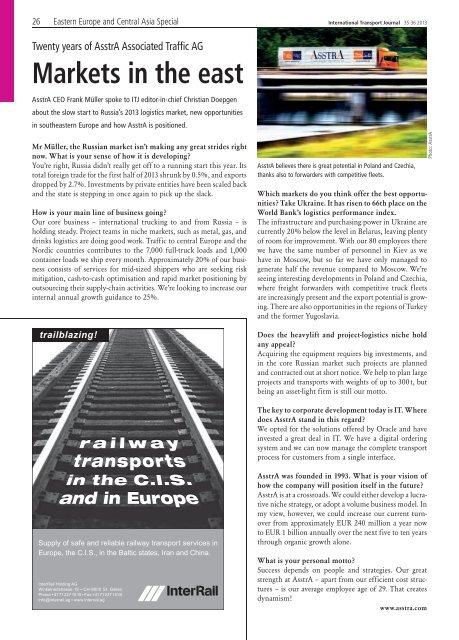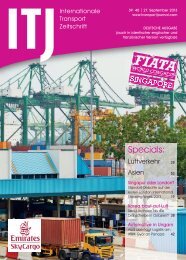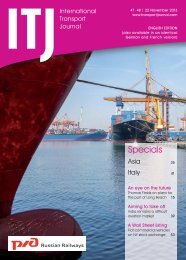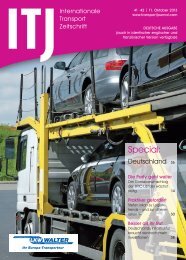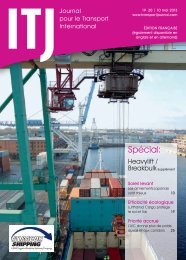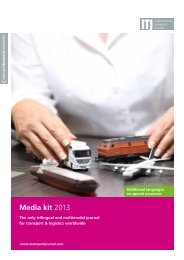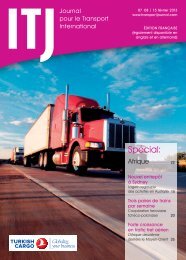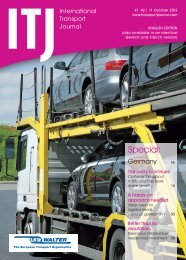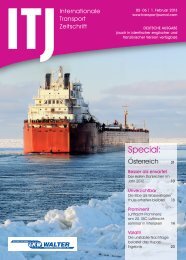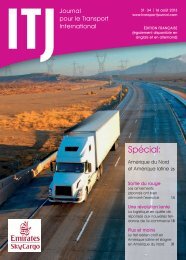Specials - ITJ | Transport Journal
Specials - ITJ | Transport Journal
Specials - ITJ | Transport Journal
- No tags were found...
Create successful ePaper yourself
Turn your PDF publications into a flip-book with our unique Google optimized e-Paper software.
26 Eastern Europe and Central Asia Special International <strong>Transport</strong> <strong>Journal</strong> 35-36 2013Twenty years of AsstrA Associated Traffic AGMarkets in the eastAsstrA CEO Frank Müller spoke to <strong>ITJ</strong> editor-in-chief Christian Doepgenabout the slow start to Russia’s 2013 logistics market, new opportunitiesin southeastern Europe and how AsstrA is positioned.Mr Müller, the Russian market isn’t making any great strides rightnow. What is your sense of how it is developing?You’re right, Russia didn’t really get off to a running start this year. Itstotal foreign trade for the first half of 2013 shrunk by 0.5%, and exportsdropped by 2.7%. Investments by private entities have been scaled backand the state is stepping in once again to pick up the slack.How is your main line of business going?Our core business – international trucking to and from Russia – isholding steady. Project teams in niche markets, such as metal, gas, anddrinks logistics are doing good work. Traffic to central Europe and theNordic countries contributes to the 7,000 full-truck loads and 1,000container loads we ship every month. Approximately 20% of our businessconsists of services for mid-sized shippers who are seeking riskmitigation, cash-to-cash optimisation and rapid market positioning byoutsourcing their supply-chain activities. We’re looking to increase ourinternal annual growth guidance to 25%.AsstrA believes there is great potential in Poland and Czechia,thanks also to forwarders with competitive fleets.Which markets do you think offer the best opportunities?Take Ukraine. It has risen to 66th place on theWorld Bank’s logistics performance index.The infrastructure and purchasing power in Ukraine arecurrently 20% below the level in Belarus, leaving plentyof room for improvement. With our 80 employees therewe have the same number of personnel in Kiev as wehave in Moscow, but so far we have only managed togenerate half the revenue compared to Moscow. We’reseeing interesting developments in Poland and Czechia,where freight forwarders with competitive truck fleetsare increasingly present and the export potential is growing.There are also opportunities in the regions of Turkeyand the former Yugoslavia.Photo: AsstrADoes the heavylift and project-logistics niche holdany appeal?Acquiring the equipment requires big investments, andin the core Russian market such projects are plannedand contracted out at short notice. We help to plan largeprojects and transports with weights of up to 300 t, butbeing an asset-light firm is still our motto.The key to corporate development today is IT. Wheredoes AsstrA stand in this regard?We opted for the solutions offered by Oracle and haveinvested a great deal in IT. We have a digital orderingsystem and we can now manage the complete transportprocess for customers from a single interface.AsstrA was founded in 1993. What is your vision ofhow the company will position itself in the future?AsstrA is at a crossroads. We could either develop a lucrativeniche strategy, or adopt a volume business model. Inmy view, however, we could increase our current turnoverfrom approximately EUR 240 million a year nowto EUR 1 billion annually over the next five to ten yearsthrough organic growth alone.What is your personal motto?Success depends on people and strategies. Our greatstrength at AsstrA – apart from our efficient cost structures– is our average employee age of 29. That createsdynamism!www.asstra.com


